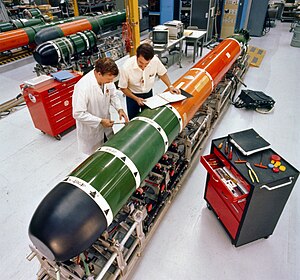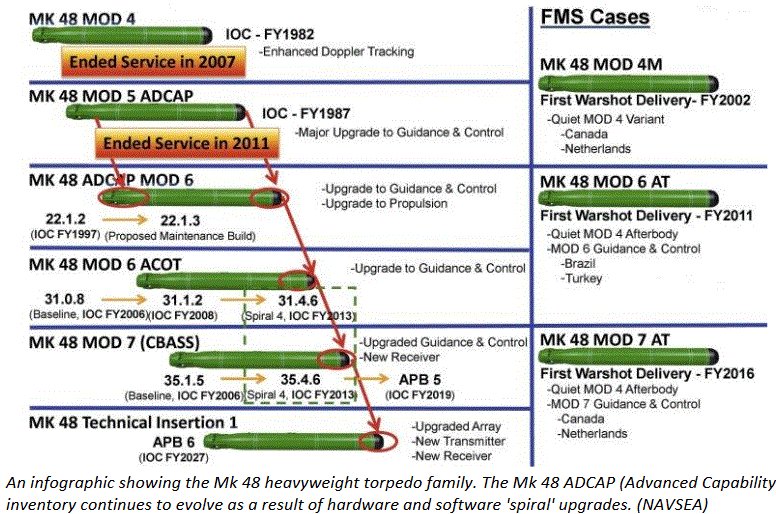
The RUR-5 ASROC is an all-weather, all sea-conditions anti-submarine missile system. Developed by the United States Navy in the 1950s, it was deployed in the 1960s, updated in the 1990s, and eventually installed on over 200 USN surface ships, specifically cruisers, destroyers, and frigates. The ASROC has been deployed on scores of warships of many other navies, including Canada, Germany, Italy, Japan, Taiwan, Greece, Pakistan and others.

The Sturgeon class was a class of nuclear-powered fast attack submarines (SSN) in service with the United States Navy from the 1960s until 2004. They were the "workhorses" of the Navy's attack submarine fleet throughout much of the Cold War. The boats were phased out in the 1990s and early 21st century, as their successors, the Los Angeles, followed by the Seawolf and Virginia-class boats, entered service.
The Mark 24 Tigerfish was a heavyweight acoustic homing torpedo used by the Royal Navy (RN) during the 1980s and 90s. Conceptual development dates to the mid-1950s, and formally started in 1959 with a target introduction date in 1969. A lengthy development process led to a greatly reduced performance requirement, including the removal of anti-surface capabilities. The first prototype "Tiger Fish" examples were delivered in 1967.
The Spearfish torpedo is the heavy torpedo used by the submarines of the Royal Navy. It can be guided by wire or by autonomous active or passive sonar, and provides both anti-submarine warfare (ASW) and anti-surface warfare (ASuW) capability. Spearfish development began in the 1970s, with production starting in 1988, and deployment in 1992. By 2004, the new weapon had completely replaced the older Tigerfish torpedo.

HMCS Victoria is a long-range hunter-killer (SSK) submarine of the Royal Canadian Navy, the lead ship of her class. She is named after the city of Victoria, British Columbia. She was purchased from the Royal Navy, and is the former HMS Unseen (S41). The class was also renamed from the Upholder class.

HMAS Farncomb is the second of six Collins-class submarines operated by the Royal Australian Navy (RAN). Named for Rear Admiral Harold Farncomb, the submarine was laid down in 1993 and launched in December 1995—the first submarine to be completely constructed in Australia. A combination of factors led to Farncomb being the only vessel of her class in operational condition in mid-2009.

HMAS Waller is the third of six Collins-class submarines operated by the Royal Australian Navy (RAN).
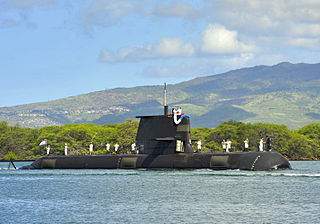
HMAS Sheean is the fifth of six Collins-class submarines operated by the Royal Australian Navy (RAN).

HMAS Rankin is the sixth and final submarine of the Collins class, which are operated by the Royal Australian Navy (RAN). Named for Lieutenant Commander Robert William Rankin, the boat was laid down in 1995, and commissioned into the RAN in March 2003, following major delays.

The Permit-class submarine was a class of nuclear-powered fast attack submarines in service with the United States Navy from the early 1960s until 1996. They were a significant improvement on the Skipjack class, with greatly improved sonar, diving depth, and silencing. They were the forerunners of all subsequent US Navy SSN designs. They served from the 1960s through to the early 1990s, when they were decommissioned due to age. They were followed by the Sturgeon and Los Angeles classes.

The Halifax-class frigate, also referred to as the City class, is a class of multi-role patrol frigates that have served the Royal Canadian Navy since 1992. The class is the outcome of the Canadian Patrol Frigate Project, which dates to the mid-1970s. HMCS Halifax was the first of an eventual twelve Canadian-designed and Canadian-built vessels which combine traditional anti-submarine capabilities with systems to deal with surface and air threats as well. Ships of the class are named after capital cities of Canadian provinces, the capital of Canada, Ottawa, and the major cities of Calgary, Montreal, and Vancouver.
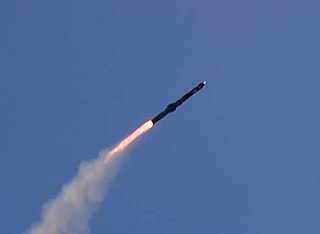
The RUM-139 Vertical Launch Anti-Submarine Rocket is an anti-submarine missile in the ASROC family, currently built by Lockheed Martin for the U.S. Navy.

The Mark 54 Lightweight Torpedo is a standard 12.75-inch (324 mm) anti-submarine warfare (ASW) torpedo used by the United States Navy.

The Sting Ray is a British acoustic homing lightweight torpedo (LWT) manufactured by GEC-Marconi, who were later bought out by BAE Systems. It entered service in 1983.

HMCS Ottawa is a Royal Canadian Navy Halifax-class frigate. Ottawa is the twelfth and final ship of the Halifax class that were built as part of the Canadian Patrol Frigate Project. She is the fourth vessel to carry the name HMCS Ottawa. The first three were named for the Ottawa River. This ship is the first named for Canada's national capital, the City of Ottawa. She is assigned to Maritime Forces Pacific (MARPAC) and is homeported at HMC Dockyard, CFB Esquimalt. Ottawa serves on MARPAC missions protecting Canada's sovereignty in the Pacific Ocean and enforcing Canadian laws in its territorial sea and Exclusive Economic Zone. Ottawa has also been deployed on missions throughout the Pacific and to the Indian Ocean; specifically the Persian Gulf and Arabian Sea on anti-terrorism operations.

The California class was a pair of nuclear-powered guided-missile cruisers operated by the United States Navy between 1974 and 1998. Other than their nuclear power supply and lack of helicopter hangars, ships of the California class were comparable to other guided-missile cruisers of their era, such as the Belknap class. The class was built as a follow-up to the nuclear-powered Long Beach, Bainbridge, and Truxtun classes. Like all of the nuclear cruisers, which could steam for years between refuelings, the California class was designed in part to provide high endurance escort for the navy's nuclear aircraft carriers, which were often limited in range due to their conventionally powered escorts continuously needing to be refueled.

An acoustic torpedo is a torpedo that aims itself by listening for characteristic sounds of its target or by searching for it using sonar. Acoustic torpedoes are usually designed for medium-range use, and often fired from a submarine.

The Mark 37 torpedo is a torpedo with electrical propulsion, developed for the US Navy after World War II. It entered service with the US Navy in the early 1950s, with over 3,300 produced. It was phased out of service with the US Navy during the 1970s, and the stockpiles were sold to foreign navies.
DM2A4 Seehecht is the latest heavyweight torpedo developed by Atlas Elektronik for the German Navy, as a further update of DM2 torpedo which was released in 1976.
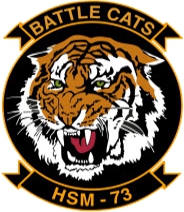
Helicopter Maritime Strike Squadron 73 (HSM-73) is a United States Navy Maritime Strike helicopter squadron based on Naval Air Station North Island, California.
